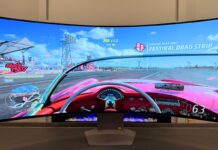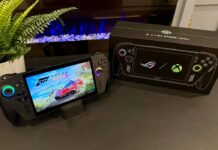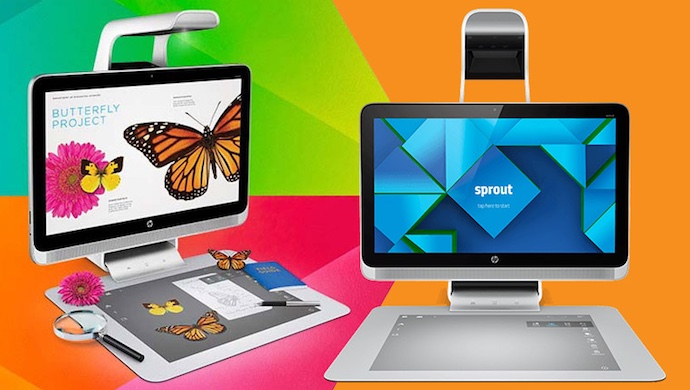
The HP Sprout is something new in the PC world, a computer that HP says will enable anyone to “grab something from the real world, manipulate it in the digital world, and bring it to life in physical space.”
This all happens in a sequence that HP describes as “Grab, mash and make.” That’s a pretty low tech way to put a process that used to require a collection of expensive and highly specialized gear, along with software and plenty of know-how.
Lack of Content Has Held Back 3D Printers
Any conversation about the HP Sprout has to start with 3D printing.
We’ve been watching as 3D printers make the move from industrial prototypers and futuristic manufacturing tools to models aimed at consumers and small businesses. This has been great for hobbyists and I’m always reading about the cool stuff medical researchers and others are doing by using these devices—3D printing prosthetic limbs and other really useful applications.
3D printers are reaching the stage where they’re reasonably affordable, with models designed for home and small office use and print supplies readily available.
But when it comes to the average person owning a 3D printer, content has been a real challenge. I got to spend some time with a Cube 3D printer earlier this year (it really is coming soon to Best Buy, by the way) and one of the biggest frustrations I had was finding the digital files needed to 3D print objects. There are only so many bracelets and chess pieces you can watch taking shape … There are online sources and a community of 3D printing enthusiasts who are adding more objects all the time—along with companies that are beginning to distribute the files needed to print 3D versions of their own products, including smartphone cases and pop culture collectibles.
But content remains tough to find. Actually, let me clarify that. There’s plenty of content, just not necessarily the specific content you want.
And that’s where the HP Sprout comes into the picture. This is a product that’s designed to take care of everything before the 3D printing actually takes place. Essentially, you find the object you want to duplicate, the HP Sprout does its thing and you end up with the digital model needed for your 3D printer to work its magic.
No searching for files because you create the file.
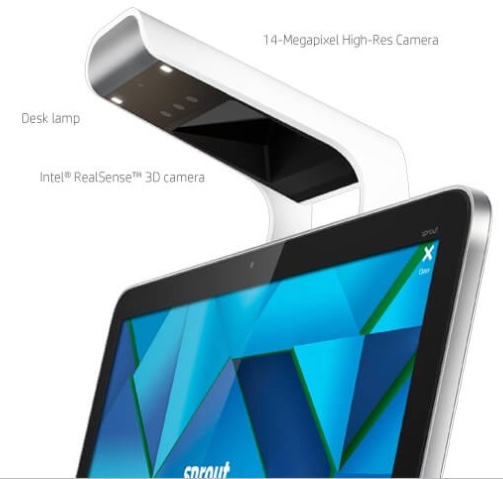 Built-in 3D Scanner Featuring Intel RealSense 3D Technology
Built-in 3D Scanner Featuring Intel RealSense 3D Technology
Mounted to the top of the Sprout is an unusual looking device called the Illuminator.
Inside, it’s packed with sophisticated technology, including an Intel RealSense 3D camera with three lenses that can track motion and interpret depth. An additional high resolution 14.4MP camera captures 220 dpi 3D scans in full colour.
There’s also a desk lamp to ensure an object to be scanned is correctly lit (they literally thought of everything).
The 3D scanning process is largely automated. Place the object to be scanned on the mat, click a button and the Illuminator starts to work, capturing it as a three dimensional model. You’ll be prompted to rotate the object (so it can be scanned from multiple angles) and then the Sprout stitches all the images together to form an accurate, high resolution digital 3D model. An optional 3D Capture Stage makes the scanning process almost entirely automated, even doing the rotation for you.
For you old school types, the Illuminator can also be used to capture high resolution images of 2D objects—that’s documents and photos—although that’s hardly a challenge given the advanced technology in this thing.
Project Your 3D Object Model
Once you have the object scanned and a 3D model has been created, the DLP projector within the Illuminator is used to project the object and display it on the Touch Mat.
That’s a very futuristic touch that expands your available workspace far beyond the traditional computer display area.
All-Touch User Interface to Interact With and Manipulate 3D Models
The Touch Mat is a scratch-resistant, spill-proof 20-point multitouch surface that snaps into the base of the HP Sprout. Combined with the digital projector, and the 23-inch touchscreen display it turns the PC into a 3D workstation.
Work with the digital models prior to printing, manipulating the shape, combining multiple objects or re-sizing them. You can add support structures, trim edges, change textures and take other steps to maximize the likelihood of a successful print. You use your hands to control the process, making it as natural as possible. You can also interact with the Sprout the old fashioned way (with a keyboard and mouse), or use a stylus.
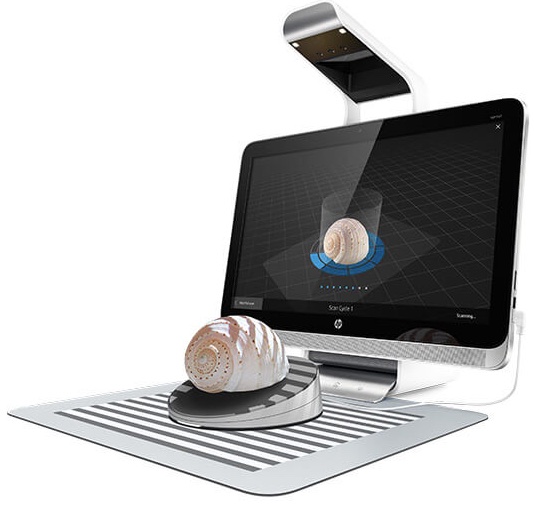
Sprout Workspace Adds 3D Apps to the Mix
Third party software and apps in the Sprout Workspace extend your ability to manipulate the 3D models you create. Applications like Microsoft 3D Builder and Autodesk Meshmixer are compatible with the HP Sprout, each giving additional abilities.
With the right software, you could also design your own 3D object from scratch.
It’s Also a Powerful All-in-One PC
This part is nowhere near as exciting as having a built-in 3D scanner and a giant Touch Mat for manipulating 3D objects, but it’s worth noting that the HP Sprout is also a very powerful All-in-One Windows PC. With an Intel Core i7 CPU, a hybrid SSD drive, Nvidia GeForce GT graphics card (with 2GB of RAM) and a 23-inch Full HD touchscreen display, this a high performance computer.
Also included are a Bluetooth keyboard and mouse, and an Adonit Jot Pro Stylus.
The HP Sprout is really something new in the PC space. It’s not just unusual looking, its customized hardware turns it into a true 3D workstation, able to handle every stage of the 3D printing process from creation of the model to the point where it’s ready to print. Ideally, this PC would be sitting beside a 3D printer on your desk, but even if you don’t take that final step of buying a printer, HP is partnering with 3D print service providers so you can upload your creation and have it delivered.
Look for the HP Sprout to be at available at Best Buy in the coming weeks.

